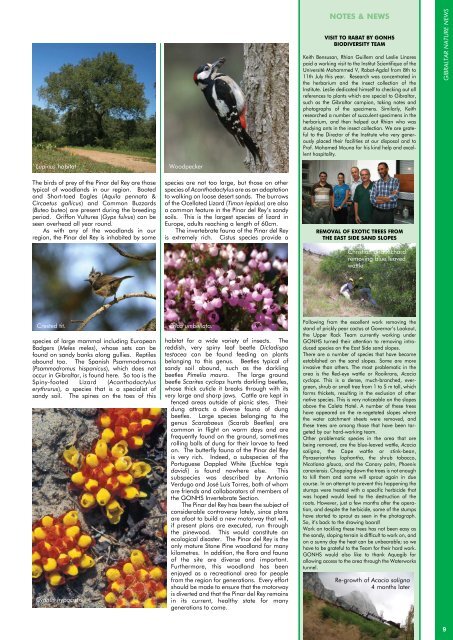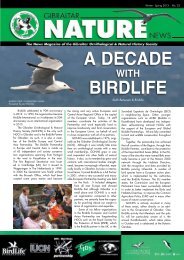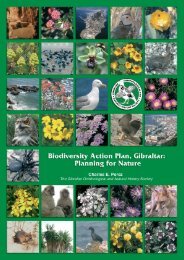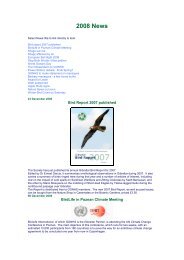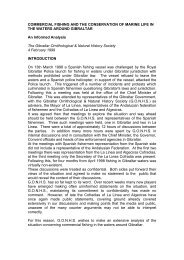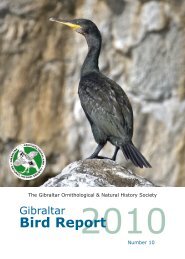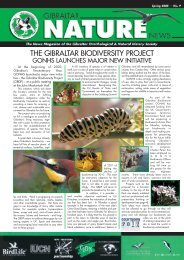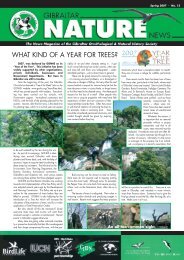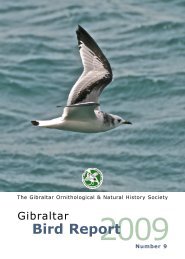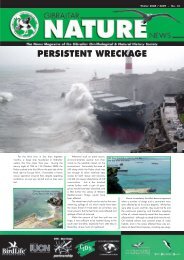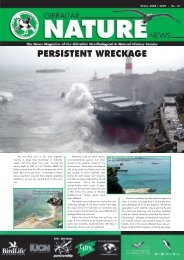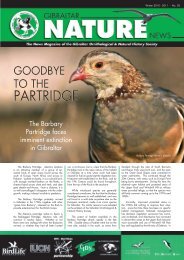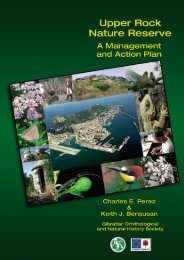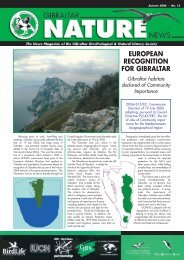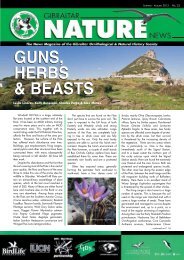No.15 - Gibraltar Ornithological & Natural History Society
No.15 - Gibraltar Ornithological & Natural History Society
No.15 - Gibraltar Ornithological & Natural History Society
Create successful ePaper yourself
Turn your PDF publications into a flip-book with our unique Google optimized e-Paper software.
Lupinus habitat<br />
The birds of prey of the Pinar del Rey are those<br />
typical of woodlands in our region. Booted<br />
and Short-toed Eagles (Aquila pennata &<br />
Circaetus gallicus) and Common Buzzards<br />
(Buteo buteo) are present during the breeding<br />
period. Griffon Vultures (Gyps fulvus) can be<br />
seen overhead all year round.<br />
As with any of the woodlands in our<br />
region, the Pinar del Rey is inhabited by some<br />
Crested tit.<br />
species of large mammal including European<br />
Badgers (Meles meles), whose sets can be<br />
found on sandy banks along gullies. Reptiles<br />
abound too. The Spanish Psammodromus<br />
(Psammodromus hispanicus), which does not<br />
occur in <strong>Gibraltar</strong>, is found here. So too is the<br />
Spiny-footed Lizard (Acanthodactylus<br />
erythrurus), a species that is a specialist of<br />
sandy soil. The spines on the toes of this<br />
Cytinus hypocistis<br />
Woodpecker<br />
species are not too large, but those on other<br />
species of Acanthodactylus are as an adaptation<br />
to walking on loose desert sands. The burrows<br />
of the Ocellated Lizard (Timon lepidus) are also<br />
a common feature in the Pinar del Rey’s sandy<br />
soils. This is the largest species of lizard in<br />
Europe, adults reaching a length of 60cm.<br />
The invertebrate fauna of the Pinar del Rey<br />
is extremely rich. Cistus species provide a<br />
Erica umbellata.<br />
habitat for a wide variety of insects. The<br />
reddish, very spiny leaf beetle Dicladispa<br />
testacea can be found feeding on plants<br />
belonging to this genus. Beetles typical of<br />
sandy soil abound, such as the darkling<br />
beetles Pimelia maura. The large ground<br />
beetle Scarites cyclops hunts darkling beetles,<br />
whose thick cuticle it breaks through with its<br />
very large and sharp jaws. Cattle are kept in<br />
fenced areas outside of picnic sites. Their<br />
dung attracts a diverse fauna of dung<br />
beetles. Large species belonging to the<br />
genus Scarabaeus (Scarab Beetles) are<br />
common in flight on warm days and are<br />
frequently found on the ground, sometimes<br />
rolling balls of dung for their larvae to feed<br />
on. The butterfly fauna of the Pinar del Rey<br />
is very rich. Indeed, a subspecies of the<br />
Portuguese Dappled White (Euchloe tagis<br />
davidi) is found nowhere else. This<br />
subspecies was described by Antonio<br />
Verdugo and José Luís Torres, both of whom<br />
are friends and collaborators of members of<br />
the GONHS Invertebrate Section.<br />
The Pinar del Rey has been the subject of<br />
considerable controversy lately, since plans<br />
are afoot to build a new motorway that will,<br />
if present plans are executed, run through<br />
the pinewood. This would constitute an<br />
ecological disaster. The Pinar del Rey is the<br />
only mature Stone Pine woodland for many<br />
kilometres. In addition, the flora and fauna<br />
of the site are diverse and important.<br />
Furthermore, this woodland has been<br />
enjoyed as a recreational area for people<br />
from the region for generations. Every effort<br />
should be made to ensure that the motorway<br />
is diverted and that the Pinar del Rey remains<br />
in its current, healthy state for many<br />
generations to come.<br />
notes & neWs<br />
Visit to rABAt BY Gonhs<br />
BiodiVersitY teAm<br />
Keith Bensusan, Rhian Guillem and Leslie Linares<br />
paid a working visit to the Institut Scientifique of the<br />
Université Mohammed V, Rabat-Agdal from 8th to<br />
11th July this year. Research was concentrated in<br />
the herbarium and the insect collection of the<br />
Institute. Leslie dedicated himself to checking out all<br />
references to plants which are special to <strong>Gibraltar</strong>,<br />
such as the <strong>Gibraltar</strong> campion, taking notes and<br />
photographs of the specimens. Similarly, Keith<br />
researched a number of succulent specimens in the<br />
herbarium, and then helped out Rhian who was<br />
studying ants in the insect collection. We are grateful<br />
to the Director of the Institute who very generously<br />
placed their facilities at our disposal and to<br />
Prof. Mohamed Mouna for his kind help and excellent<br />
hospitality.<br />
remoVAL of eXotic trees from<br />
the eAst side sAnd sLoPes<br />
Christian and Richard<br />
removing blue leaved<br />
wattle<br />
Following from the excellent work removing the<br />
stand of prickly pear cactus at Governor’s Lookout,<br />
the Upper Rock Team currently working under<br />
GONHS turned their attention to removing introduced<br />
species on the East Side sand slopes.<br />
There are a number of species that have become<br />
established on the sand slopes. Some are more<br />
invasive than others. The most problematic in the<br />
area is the Red-eye wattle or Rooikrans, Acacia<br />
cyclops. This is a dense, much-branched, evergreen,<br />
shrub or small tree from 1 to 5 m tall, which<br />
forms thickets, resulting in the exclusion of other<br />
native species. This is very noticeable on the slopes<br />
above the Caleta Hotel. A number of these trees<br />
have appeared on the re-vegetated slopes where<br />
the water catchment sheets were removed, and<br />
these trees are among those that have been targeted<br />
by our hard-working team.<br />
Other problematic species in the area that are<br />
being removed, are the blue-leaved wattle, Acacia<br />
saligna, the Cape wattle or stink-bean,<br />
Paraserianthes lophantha, the shrub tobacco,<br />
Nicotiana glauca, and the Canary palm, Phoenix<br />
canariensis. Chopping down the trees is not enough<br />
to kill them and some will sprout again in due<br />
course. In an attempt to prevent this happening the<br />
stumps were treated with a specific herbicide that<br />
was hoped would lead to the destruction of the<br />
roots. However, just a few months after the operation,<br />
and despite the herbicide, some of the stumps<br />
have started to sprout as seen in the photograph.<br />
So, it’s back to the drawing board!<br />
Work on tackling these trees has not been easy as<br />
the sandy, sloping terrain is difficult to work on, and<br />
on a sunny day the heat can be unbearable; so we<br />
have to be grateful to the Team for their hard work.<br />
GONHS would also like to thank Aquagib for<br />
allowing access to the area through the Waterworks<br />
tunnel.<br />
Re-growth of Acacia saligna<br />
4 months later<br />
GIBRALTAR NATURE NEWS<br />
9


